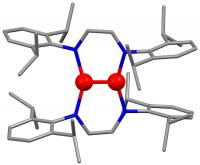|
Related Topics: |
|
|
|
Current News |
|
Chemistry A to Z |
|
About Internetchemistry |
Record-setting Chemical Bond |
|
The distance? A minuscule 1.803 �ngstroms, which is on the order of a billionth of the thickness of a human hair. The chemists weren't driven by the Guinness Book of World Records or even a friendly bet. As is often the case in science, they discovered the molecule, which has a quintuple (i.e., fivefold) bond, quite by accident. |
|
�Sometimes things like this just happen,� said Klaus Theopold, professor and chairperson of the UD Department of Chemistry and Biochemistry. Theopold and Kevin Kreisel, who graduated with his doctorate from UD in August and is now a postdoctoral researcher at the University of Wisconsin, made the finding, working with research associate Glenn Yap and postdoctoral fellow Olga Dmitrenko, both from UD, and Clark Landis, a colleague from the University of Wisconsin. The research was reported in the Journal of the American Chemical Society. Theopold has been researching the chemistry of chromium for a long time. The metal is an important industrial catalyst for making plastics such as polyethylene. �We discovered this interesting looking molecule and realized that it had an extremely short distance between the metal atoms,� Theopold said. Using an analytical technique called X-ray diffraction, the scientists were able to look directly at the atomic structure of the new molecule and measure the distance between the chromium atoms. A rule-of-thumb in chemistry, Theopold said, is that bond length and bond strength go together, so it's likely that the metal-metal bond is a strong one, although Theopold said no one knows for sure. �This molecule is probably not practically useful. We're not going to get a patent here or cure cancer,� Theopold noted. �Records define the range in which things can exist. It's just an interesting molecule from a fundamental scientific standpoint.� And those teeny-tiny bonds do mark a new world record for chemistry. Before the UD discovery, Theopold said, the last record, achieved by researchers at Texas A&M University, stood for nearly 30 years. |
|
|
|

